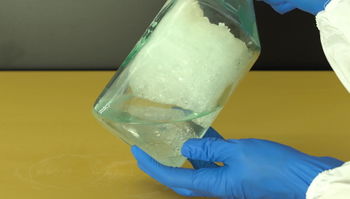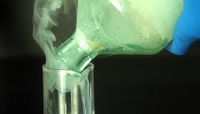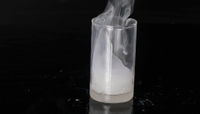Difference between revisions of "Oleum"
(Created page with "'''Oleum''' (Latin ''oleum'' - oil) or '''fuming sulfuric acid''', is a solution of various compositions of sulfur trioxide in sulfuric acid, or sometimes more specifi...") |
|||
| (5 intermediate revisions by 2 users not shown) | |||
| Line 1: | Line 1: | ||
| + | [[File:Oleum liquid and solid in bottle by ChemicalForce.jpg|thumb|350px|Liquid oleum in a glass bottle, with solidified oleum on top consisting of pyrosulfuric acid]] | ||
'''Oleum''' (Latin ''oleum'' - oil) or '''fuming sulfuric acid''', is a solution of various compositions of [[sulfur trioxide]] in [[sulfuric acid]], or sometimes more specifically in disulfuric acid (pyrosulfuric acid). Unlike concentrated sulfuric acid, oleum is volatile and cannot be safely handled without serious proper protection. | '''Oleum''' (Latin ''oleum'' - oil) or '''fuming sulfuric acid''', is a solution of various compositions of [[sulfur trioxide]] in [[sulfuric acid]], or sometimes more specifically in disulfuric acid (pyrosulfuric acid). Unlike concentrated sulfuric acid, oleum is volatile and cannot be safely handled without serious proper protection. | ||
| Line 19: | Line 20: | ||
*Make nitroaromatic compounds | *Make nitroaromatic compounds | ||
| − | == | + | ==Handling and safety== |
Oleum is highly corrosive, and will fume in open air, creating a very corrosive mist of sulfuric acid. Proper protection, like apron, gas mask, thick gloves must be worn at all times when working with this compound mixture. | Oleum is highly corrosive, and will fume in open air, creating a very corrosive mist of sulfuric acid. Proper protection, like apron, gas mask, thick gloves must be worn at all times when working with this compound mixture. | ||
| + | |||
| + | === Disposal === | ||
| + | Oleum can be neutralized by sulfuric acid with a concentration of 70-80%, which can be easily prepared by [[boiling the Bat]]; it reacts mildly and pleasantly with this solution, resulting in very useful sulfuric acid with a concentration of 98-100%. Keep adding mid-concentrated sulfuric until oleum stops fuming. Do not dispose of the resulting acid. | ||
| + | |||
| + | ==Gallery== | ||
| + | <gallery widths="200" position="center" columns="4" orientation="none"> | ||
| + | Oleum and pyrosulfuric acid fuming in air by ChemicalForce.jpg|Oleum, fuming in air | ||
| + | Liquid oleum poured in a beaker by ChemicalForce.jpg|Oleum fuming in air while being poured in another beaker | ||
| + | Solidified and melting oleum by ChemicalForce.jpg|Oleum will freeze at room temperature or lower | ||
| + | Solid and liquid oleum in beaker fuming by ChemicalForce.jpg|Oleum solidified in the beaker | ||
| + | </gallery> | ||
==See also== | ==See also== | ||
| Line 56: | Line 68: | ||
[[Category:Materials unstable in basic solution]] | [[Category:Materials unstable in basic solution]] | ||
[[Category:Materials that react with water]] | [[Category:Materials that react with water]] | ||
| + | [[Category:Liquids]] | ||
| + | [[Category:Solids]] | ||
Latest revision as of 22:50, 20 January 2020
Oleum (Latin oleum - oil) or fuming sulfuric acid, is a solution of various compositions of sulfur trioxide in sulfuric acid, or sometimes more specifically in disulfuric acid (pyrosulfuric acid). Unlike concentrated sulfuric acid, oleum is volatile and cannot be safely handled without serious proper protection.
Contents
Composition
Oleums can be described by the formula ySO3·H2O where y is the total molar sulfur trioxide content. The value of y can be varied, to include different oleums. They can also be described by the formula H2SO4·xSO3 where x is now defined as the molar free sulfur trioxide content. Oleum is generally assessed according to the free SO3 content by mass. It can also be expressed as a percentage of sulfuric acid strength; for oleum concentrations, that would be over 100%. For example, 10% oleum can also be expressed as H2SO4·0.13611SO3, 1.0225SO3·H2O or 102.25% sulfuric acid. The conversion between % acid and % oleum is: % acid = 100 + 18/80 × % oleum.[1]
Properties
Oleum is a colorless or slightly yellow oily fuming liquid, with a corrosive and pungent smell. It dissolves extremely exothermically in water, and reacts with alcohols. It is insoluble in non-polar solvents, like hydrocarbons and halocarbons. Oleum containing 60% SO3 has an average density of 2,000 g/cm3.
Oleum reacts violently with water. It will rapidly dehydrate sugars to elemental carbon.
Availability
Oleum is sold by some chemical suppliers, but due to its hazards it's almost impossible to be acquired by the amateur chemist.
Preparation
Oleum can be prepared by dissolving sulfur trioxide in concentrated sulfuric acid. SO3 is prepared from the pyrolysis of iron sulfates or pyrosulfate salts.
Projects
- Make more sulfuric acid
- Make nitroaromatic compounds
Handling and safety
Oleum is highly corrosive, and will fume in open air, creating a very corrosive mist of sulfuric acid. Proper protection, like apron, gas mask, thick gloves must be worn at all times when working with this compound mixture.
Disposal
Oleum can be neutralized by sulfuric acid with a concentration of 70-80%, which can be easily prepared by boiling the Bat; it reacts mildly and pleasantly with this solution, resulting in very useful sulfuric acid with a concentration of 98-100%. Keep adding mid-concentrated sulfuric until oleum stops fuming. Do not dispose of the resulting acid.
Gallery
See also
References
Relevant Sciencemadness threads
- Sulphur Trioxide and Oleum Using a Box Oven - Illustarted Practical Guide
- oleum & SO3
- Synthesis of Sulfur Trioxide and Oleum: The persulfate method
- The Synthesis of Sulfur Trioxide and Oleum: the vanadium (V) oxide-catalyzed method
- Sulfur trioxide & Oleum: the ferric sulfate method
- Preparation of Oleum by Use of Phosphoric Acid
- Diluting oleum
- Assay of Oleum by Titration
- Oleum prep
- oleum
- Chemical compounds
- Inorganic compounds
- Sulfur compounds
- Acids
- Strong acids
- Mineral acids
- Oxoacids
- Sulfates
- Pyrosulfates
- Oxidizing agents
- Oxidizing mixtures
- Corrosive chemicals
- Things that can kill you very quickly
- Things that should NOT be messed with except by professionals
- Hygroscopic compounds
- Materials unstable in basic solution
- Materials that react with water
- Liquids
- Solids




